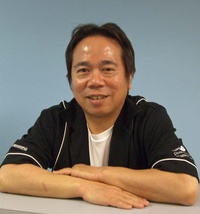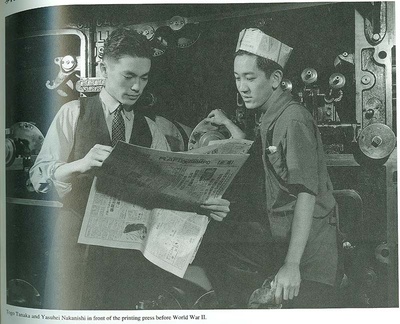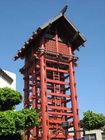The Rafu Shimpo has been in print for over 100 years. During the course of that time, it has gone through many hardships caused by both economic and social troubles, yet still runs to this day. After an interview with Michael Komai and reading the Rafu Shimpo’s 90th anniversary issue, I have written a concise history of the Rafu Shimpo from its beginning up to its initial closing during World War II.
Before the Rafu Shimpo had come to fruition in 1903, another Japanese American newspaper, Soko, was being published in San Francisco, with less than 100 subscribers. Meanwhile, as the population of Japanese Americans in Los Angeles grew, there came a large potential for readers for a Japanese newspaper.
In April of 1903, Masaharu Yamaguchi, Rippo Iijima, and Seijiro Shibuya published the first issue of the Rafu Shimpo, printed right in downtown Los Angeles. Within two years, the number of subscribers to the Rafu Shimpo increased to 400, prompting them to hire new managers in order to meet the growing demand.
Economic troubles for the Rafu Shimpo began in 1907, when Kinmon Bank closed down. Because the bank had lent money to the Rafu Shimpo, (among other newspapers) not only did this hurt funding for the paper, but the actual business itself was jeopardized when the bank commission tried to seize the Rafu Shimpo as collateral. Fortunately, the publishers were able to prevent the seizure by creating a stockholding corporation and kept the newspaper under their own leadership.
Soon after, another unfortunate incident built up from tension among farmers on Third Street and Ninth Street. A group of Japanese, Chinese, and Caucasian farmers set up a new market on Ninth Street. This, of course, created competition for the Third Street farmer’s market. As both of these markets sought to obtain produce from Japanese farmers, a very tense conflict developed in which the Rafu Shimpo became involved.
The conflict soon led to subscribers and advertisers boycotting the newspaper, as well as the Rafu Shimpo publishing personal attacks on the Rafu Asahi (another Japanese newspaper) in its editorials. Eventually, the conflict became so heated that the Japanese Business Association stepped in and sought to halt the conflict. This led to the Rafu Shimpo being sold by the bank commission, which had been previously avoided.
In April of 1910, Masao Kanno bought the Rafu Shimpo from the bank commission for a sum of $1,335. Kanno was president of the newspaper, joined by Inosuke Inose, Sho Inoue, Henry Toyosaku Komai, and the Los Angeles News Publishing Company as stockholders. A year later, Inosuke Inose took Kanno’s place as president.
In 1914, H.T. Komai became manager of the Rafu Shimpo. Inosuke Inose retained his position as president, and established a correspondence with Mitaro Kawasaki in Tokyo. Thanks to this connection to Japan, the Rafu Shimpo was able to cover the conflict in Europe during World War I in much better detail. The next year, the Los Angeles Japanese American population had grown so much that it prompted the Rafu Shimpo to move to a new location, 104 North Los Angeles Street. During this time, the newspaper featured extensive stories about discrimination against Japanese residents stemming from the Alien Land Law, which had been passed in 1913.
While keeping a broader theme with coverage of the event of World War I in Europe, the Rafu Shimpo also kept its local theme by covering stories that would be of very much interest to the surrounding community. In August 1917, the newspaper covered the story of Kanichi Hayashi, dubbed “the first Nisei soldier,” who had gone to the U.S. draft board to volunteer for military service.
In 1922, H.T. Komai became the president of the Rafu Shimpo, and published the newspaper from this time forward. As the population of Nisei continued to grow, so did the demand for an English section in the newspaper to accompany the Japanese text.
Finally, in February 1926, the Rafu Shimpo had published its first issue with an English section, along with an additional three pages in English. These additional pages contained articles about Japan in order to teach Nisei about the country where their parents once resided. Louise Suski became the first English editor during this time. After ten years, in 1936, Suski was joined by Togo Tanaka as the co-editor of the English section.
By the 1930s, both the Issei and Nisei had long been part of the United States, yet were still seen as “other” by the country at large. As Tanaka puts it, “Our state and federal government had by law made the Issei second-class non-citizens. They were our parents… they were no longer visitors or sojourners. They were permanent residents with American citizen children. But our nation’s statutes classified them as ‘aliens ineligible to United States citizenship’.”
This attitude toward Japanese during the events of World War II, caused by a combination of racial bigotry and Japan’s actions toward Korea and China would amplify the prejudice towards Japanese individuals in 1941.
On the morning of December 7, 1941, the Japanese navy attacked Pearl Harbor. That afternoon, H.T. Komai was arrested by the FBI. Soon after, the English editors, as well as leaders in the Japanese American community, were picked up and held by the FBI. Soon after, the Rafu Shimpo would have to change their publication according to whatever standards were set by the government.
Although the newspaper closed the day after the attack on Pearl Harbor, the Rafu Shimpo was able to release an issue the following day, December 9th. That day, only two pages were released in English. The Japanese text had been censored to be blank. The newspaper was allowed to resume the printing of the Japanese articles on December 10th, but only if they were submitted to the post office for review.
On April 4, 1942, the Rafu Shimpo released its last issue. It contained an editorial stating, “Itsuka mata omemoji no hi made (Until we meet again)” and was signed “Before long, we will be ‘your Rafu Shimpo’ again.”
In just under four years, the Rafu Shimpo resumed publication on January 1, 1946.
** Discover Nikkei partnered with Professor Morgan Pitelka of Occidental College and his students taking the Spring 2010 seminar “Japanophilia: Orientalism, Nationalism, Transnationalism” on a meaningful community-based documentation project. The students interviewed owners of five long-time Little Tokyo businesses to create Nikkei Albums and articles.
View the Nikkei Album: A Look at the Rafu Shimpo
© 2010 David Wagner






